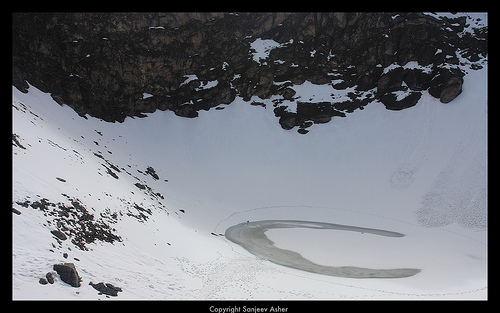Hundreds of skeletons found dead of unknown causes
In the midst of WWII, a British forest guard came across an alarming sight in the northern mountains of India: hundreds of human skeletons surrounding a high alpine lake. At the time, the British military worried that the skeletons might have been from Japanese soldiers trying to sneak into British territory, so they sent a squad of archaeologists out to examine the remains.
Roopkund, known as the "Skeleton Lake," is located in an uninhabited area of the Himalayas, near the intersection of India, Tibet, and Nepal. The lake is at 16,500 feet above sea level, and the extreme cold temperatures and lack of human contact helped preserve the skeletal remains (and some bits of skin and hair) for hundreds of years.
What the archaeologists quickly concluded was that the skeletons were ancient, dating to about 850 AD. They came from two groups of people: a group of people who were closely related (either a large family or a small tribe), and a smaller group of shorter people. Based on the way they were dressed, as ascertained from remains like metal rings and durable spears, the archaeologists decided that the skeletons belonged to a large group of people who had been traveling through the mountains. The related people were the travelers, and the group of shorter people were presumed to be their hired local guides and porters. The travelers had stopped at this remote, high mountain lake, probably to refill their water supplies and rest. And then they had all died.
At the time, guesses ranged from ritual suicide to landslide and even an sudden epidemic. But in 2004 an expedition did further analysis and came to an interesting finding about the bizarre cause of death.
The cause of death was the same for everyone: blows to the skull, but not from any ordinary weapons. All of the blows had been caused by hard, spherical objects, and all had landed on the head and shoulders, as if coming from directly above the travelers.
The scientists concluded that the culprit was a freak hailstorm, one which dropped hailstones the size of baseballs on the travelers. The lake is barren, with no rocky outcroppings or trees where you would be able to take shelter, which means that a sudden barrage of giant hailstones could turn lethal for the entire party.
Still unanswered is the question of who this large group of people was, and why they were traveling through the Himalayas. The forbidding area is on no known trade routes, and is far from the nearest human settlement.
